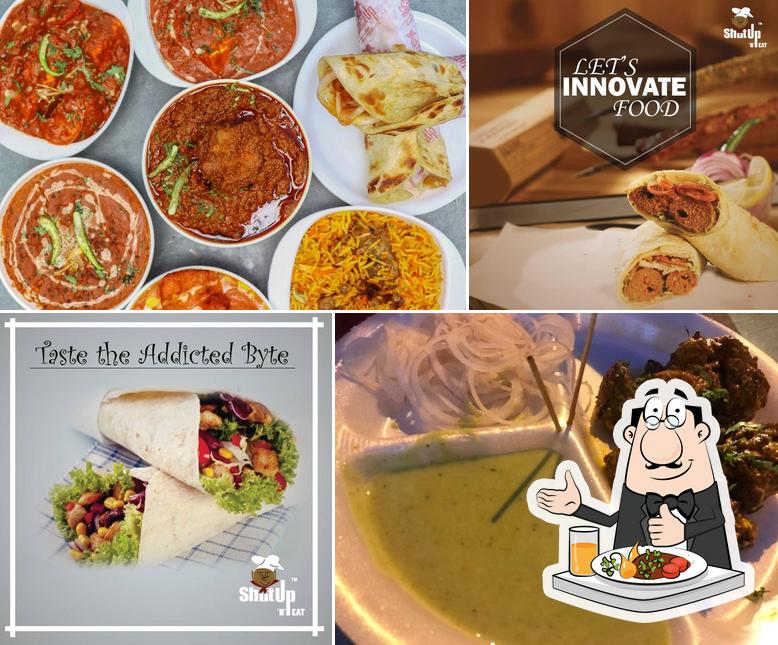Shut up and eat is a simple yet powerful phrase that has gained significant attention in recent years. It emphasizes the importance of focusing on food and enjoying the experience of eating without distractions. In a world filled with constant noise and interruptions, this mantra encourages individuals to embrace mindful eating, leading to improved physical and mental well-being.
The concept of shutting up and eating is not about silencing conversations or creating a tense atmosphere at the dinner table. Instead, it focuses on fostering a deeper connection with the food we consume and appreciating the flavors, textures, and aromas that each meal brings. This practice can help us develop healthier eating habits and reduce overeating.
As we explore the topic in detail, this article will provide valuable insights into the benefits of mindful eating, practical tips to implement the shut up and eat philosophy, and scientific evidence supporting its effectiveness. By the end of this article, you'll have a better understanding of how to incorporate this powerful practice into your daily routine.
Read also:Edwardsville Marketplace Your Ultimate Shopping Destination
Table of Contents
- Understanding Shut Up and Eat
- The Science Behind Mindful Eating
- Benefits of Shut Up and Eat
- Practical Tips for Shut Up and Eat
- Creating a Mindful Eating Environment
- Common Challenges and Solutions
- Shut Up and Eat: A Cultural Perspective
- Shut Up and Eat for Weight Management
- The Role of Technology in Mindful Eating
- Conclusion and Next Steps
Understanding Shut Up and Eat
Shut up and eat refers to the practice of eating without distractions, allowing you to fully engage with your meal. This concept is closely tied to mindful eating, which encourages individuals to pay attention to their food and the process of eating. By eliminating external interruptions such as smartphones, television, or work-related tasks, you can enhance your dining experience and develop healthier eating habits.
What is Mindful Eating?
Mindful eating involves paying full attention to the sensory experience of eating, including taste, smell, texture, and appearance. It also encourages individuals to listen to their body's hunger and fullness cues, preventing overeating and promoting a balanced diet. This practice has been shown to improve digestion, reduce stress, and enhance overall well-being.
Why is Shut Up and Eat Important?
In today's fast-paced world, people often eat on the go or while multitasking. This can lead to mindless eating, where individuals consume more calories than needed and fail to appreciate the food they eat. Shut up and eat addresses these issues by encouraging a more intentional and mindful approach to eating.
The Science Behind Mindful Eating
Research has demonstrated the numerous benefits of mindful eating. Studies show that individuals who practice mindful eating are more likely to maintain a healthy weight, experience fewer digestive issues, and enjoy improved emotional well-being. This is because mindful eating helps regulate appetite, reduce emotional eating, and enhance the overall dining experience.
Key Findings from Scientific Studies
- Studies have shown that mindful eating can reduce binge eating episodes by up to 40%.
- Research indicates that mindful eating practices can improve insulin sensitivity, reducing the risk of type 2 diabetes.
- A 2019 study published in the Journal of the Academy of Nutrition and Dietetics found that mindful eating interventions significantly reduced obesity-related health issues.
Benefits of Shut Up and Eat
Adopting the shut up and eat philosophy offers numerous benefits, including improved digestion, better nutrient absorption, and enhanced emotional well-being. By focusing on your meal and eliminating distractions, you can develop healthier eating habits and enjoy the full sensory experience of your food.
Physical Health Benefits
- Improved digestion due to slower eating and better chewing.
- Enhanced nutrient absorption as the body processes food more efficiently.
- Reduced risk of overeating and weight gain by listening to hunger and fullness cues.
Mental Health Benefits
- Lower stress levels by reducing multitasking during meals.
- Increased enjoyment of food through heightened sensory awareness.
- Improved emotional regulation by addressing emotional eating triggers.
Practical Tips for Shut Up and Eat
Implementing the shut up and eat philosophy in your daily life can be simple with a few practical tips. These strategies will help you create a more mindful eating experience and develop healthier eating habits.
Read also:Piggy Bank Norms A Comprehensive Guide To Understanding And Implementing
1. Create a Distraction-Free Environment
Remove distractions such as smartphones, televisions, and work-related materials from your dining area. This will help you focus on your meal and fully engage with the eating experience.
2. Practice Slow Eating
Eat slowly and savor each bite, paying attention to the flavors, textures, and aromas of your food. This will enhance your enjoyment of the meal and improve digestion.
3. Use Smaller Plates and Utensils
Using smaller plates and utensils can help you control portion sizes and prevent overeating. This simple change can significantly impact your eating habits and overall health.
Creating a Mindful Eating Environment
Designing a mindful eating environment is essential for successfully implementing the shut up and eat philosophy. This involves setting the right atmosphere, choosing appropriate tableware, and fostering a positive dining experience.
Setting the Atmosphere
Create a calm and inviting atmosphere by dimming the lights, playing soft background music, and using candles or flowers to enhance the dining experience. These elements can help reduce stress and promote relaxation during meals.
Selecting the Right Tableware
Choose tableware that enhances the sensory experience of eating, such as plates with contrasting colors or unique textures. This can make your meals more enjoyable and encourage mindful eating practices.
Common Challenges and Solutions
While the shut up and eat philosophy offers numerous benefits, some individuals may face challenges in implementing this practice. Understanding these obstacles and finding effective solutions can help you overcome them and develop healthier eating habits.
Challenge: Busy Schedules
Solution: Prioritize meal times by scheduling them into your daily routine. This will ensure you have dedicated time to focus on your food and enjoy the eating experience.
Challenge: External Distractions
Solution: Establish boundaries with family members or coworkers to minimize interruptions during meals. This can help you maintain a distraction-free environment and practice mindful eating.
Shut Up and Eat: A Cultural Perspective
The concept of shut up and eat is not new and has roots in various cultures around the world. Many traditional societies emphasize the importance of focusing on food and enjoying the dining experience without distractions. Exploring these cultural practices can provide valuable insights into the benefits of mindful eating.
Examples of Cultural Practices
- In Japan, the practice of "hara hachi bu" encourages individuals to eat until they are 80% full, promoting mindful eating and portion control.
- In Italy, meals are often treated as social events, with families gathering around the table to enjoy food and conversation without distractions.
- In India, the tradition of eating with your hands fosters a deeper connection with food and enhances the sensory experience of eating.
Shut Up and Eat for Weight Management
For those looking to manage their weight, the shut up and eat philosophy can be an effective tool. By focusing on your food and eliminating distractions, you can develop healthier eating habits and maintain a balanced diet.
Tips for Weight Management
- Practice portion control by using smaller plates and utensils.
- Listen to your body's hunger and fullness cues to prevent overeating.
- Choose nutrient-dense foods that provide lasting energy and satisfaction.
The Role of Technology in Mindful Eating
While technology can be a source of distraction during meals, it can also be a valuable tool for promoting mindful eating. Various apps and devices are available to help individuals track their eating habits, monitor portion sizes, and improve their overall dining experience.
Popular Mindful Eating Apps
- Am I Hungry?: This app helps users identify emotional eating triggers and develop healthier eating habits.
- Rise: A nutrition coaching app that provides personalized guidance and support for mindful eating.
- HabitBull: A habit tracking app that allows users to monitor their mindful eating progress and set achievable goals.
Conclusion and Next Steps
Shut up and eat is a powerful philosophy that encourages individuals to focus on their food and enjoy the eating experience without distractions. By implementing the strategies discussed in this article, you can develop healthier eating habits, improve your overall well-being, and enhance your dining experience.
We invite you to take action by sharing this article with friends and family, leaving a comment with your thoughts, or exploring other articles on our website. Together, we can promote mindful eating and create a healthier, more mindful world.


